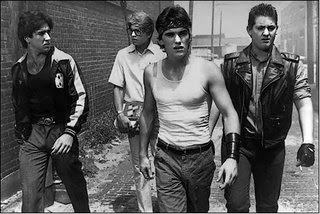
“I saw Matt Dillon in black and white there ain’t no colour in memories“
Rumble Fish is a story about alienated youth, told as straight and emotionally as possibly. The subjects of this kingdom are turned back and forth, the world runs through them. They scratch and claw against what they have been placed in, stretching the limiting situations that society and family has put them in.

“He’s merely miscast in a play. He was born in the wrong era, on the wrong side of the river… With the ability to be able to do anything that he wants to do and… finding nothing that he wants to do. I mean nothing.“
Luckily, Rumble Fish is not realistic. The gang violence is choreographed, like in A Clockwork Orange. For every single scene, Coppola has sought far and wide for that one camera angle and light-setup that drenches the dialogue with as much as fatal, foreboding meaning as is possible. The focus is often from the side or from below, or from far above. Smoke is always seeping out from the sewers and coming out from the brick walls, swimming over the asfalt, turning to thick fog in the back alleys. Firesteps, bars, filthy apartments are framed by damp lights, dust, shadows where darkness, the unknown, the undefined is eagerly waiting to take the upper hand.
“California’s like a beautiful, wild… beautiful, wild girl on heroin… who’s high as a kite, thinkin’ she’s on top of the world, not knowing she’s dying even if you show her the marks.”
The soundtrack has a distinct eighties feel, while at the same time referring nostalgically to the fifties and exotic American places like New Orleans. Where does the movie take place? Fastforwarded images of the sun reflecting in the big city skyline have been edited into between scenes, while the kids drift aimlessly on deserted smalltown streets. All the production team’s technlogical know-how – sound editing, camera control, lightning, musical composition, actor instruction – has been employed to give us the feeling of timelessness and mythological accessibility. The exact geographical location is actually Tulsa, Oklohama, that is a mythological nowhere, teenage wasteland, kingdom of dead-end youth.
With The Outsiders and Rumble Fish, teenage author S.E Hinton created some of the most memorable characters of modern popular culture. She also wrote the script for Rumble Fish in less than two weeks “on one of the first personal computers“.
“If you gonna lead people, you have to have somewhere to go“
(Deleuze och Guattari, ’68 Did Not Take Place)



